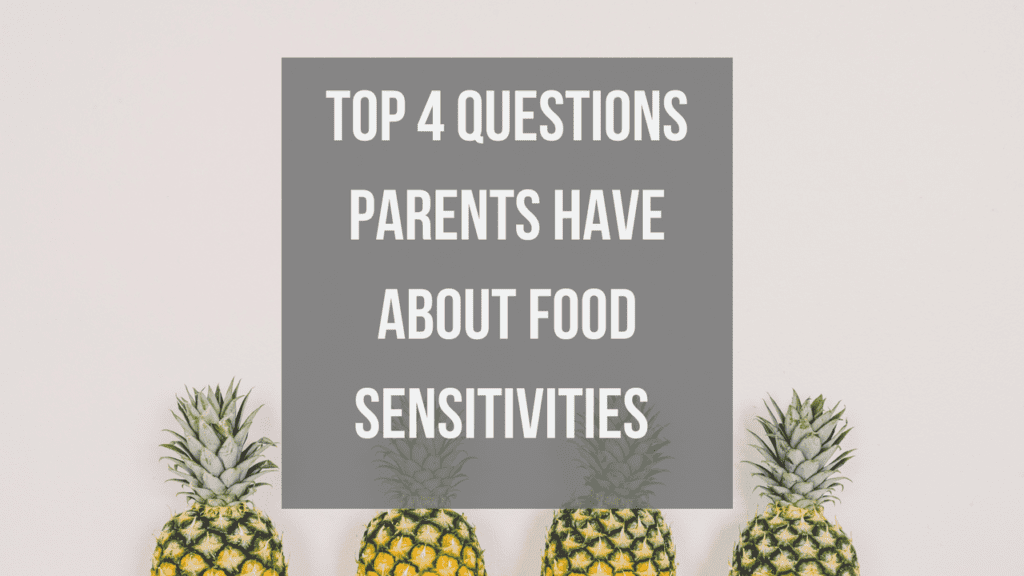Most cultures center around food. Holidays and family gatherings are marked with special meals, dishes, and recipes that are oftentimes passed down through generations. Pop’s eggnog recipe he brought back from the war. Mom’s crab dip and pizza bread on Christmas Eve. Pappy’s ribs smothered in his secret barbecue spice blend.
Your child’s food sensitivities can feel limiting and overwhelming as you recognize ingredients or additives that need to be removed. You will probably find yourself standing in front of your pantry looking at all of the foods your child can not have. Restaurants, birthday parties, and drive-throughs may now seem impossible. How do you make these changes while balancing the rest of your life? Where do you even start?
Let’s take a look at the top questions parents in your shoes have.
Why now?
“I’ve been giving my child strawberries forever, why is she reacting now? My son loves milk, why is it suddenly on the list of things he shouldn’t have?”
Food sensitivities can surface when solid foods are being introduced to young children, but for some people, they surface during puberty or even during or after pregnancy when the body is undergoing major changes. Food sensitivities can go unidentified for a long time, as the symptoms can be vague and are often blamed on other things. Test don’t guess! If you know the potential culprits upfront, you can begin to address them!
What is an Allergy vs. a Sensitivity or Intolerance?
A food allergy is an immune system reaction that occurs soon after eating a certain food, usually within two hours. A food allergy is potentially life-threatening and EpiPens are often carried in case of accidental exposure. The top 8 food allergens are milk, eggs, fish, shellfish, tree nuts, peanuts, wheat, and soy. Some people react to only one category, while others could react to almost all of them.
A food sensitivity or intolerance is an abnormal response to food without an immunological response. Food sensitivities are difficult to diagnose because symptoms can be sporadic and delayed for up to 3 days. How many times have you had indigestion and thought, “What did I have for lunch earlier?” I bet you don’t regularly think: “What did I have for lunch three days ago?” Some symptoms of food sensitivities are skin problems, yeast, weight issues, digestive trouble, sinus issues, gas, bloating, excess mucus, and runny nose. All of these symptoms overlap a variety of other things that can be going on with the body, making food sensitivities tough to identify without specific testing. (Did I already say, “TEST DON’T GUESS!?”)
Where do I start?
Change is challenging but possible. Here are three things you can do to help ease the process of navigating newly identified food sensitivities. At the end of this article, I linked two additional blog posts that provide even more tips and tricks!
- Find foods with ingredient lists that you can actually read and understand. These foods are often found on the perimeter of the grocery store or in diet-specific sections of the store.
- Buy organic when possible for the EWG’s Dirty Dozen. Frozen fruits and veggies are also great choices because they are picked at the peak of ripeness and flash-frozen soon after to preserve the optimal nutrition benefits.
- Join support groups or diet-specific groups on Facebook or Instagram and follow blogs of food influencers. I list a few at the end of this article that you can check out!
Is This Forever?
Not necessarily. When your child’s body is suffering from underlying inflammation, leaky gut, bacterial infections, dysbiosis, or more, it can not deal with any added stress. For example, eating dairy may be the “straw that breaks the camel’s back” and sends your child into a tic storm that can last minutes to weeks. The functional lab testing we perform gives us a full picture of what’s happening “under the hood” for your child. We use this data to establish a plan for your child to reach optimal wellness.
Our goal is to reintroduce foods one at a time when the time is right. Once your child’s body has had time to heal any infections, imbalances, and/or vitamin or nutrient deficiencies, he/she may be able to tolerate a food they were formerly unable to eat. Our end goal is to have your child eating food that makes him/her feel good!
In Conclusion
It is overwhelming to hear that changes involving food habits need to be made. You and your family members may feel stress, sadness, and even anger. I felt this way, too, in the beginning. YOU ARE NOT ALONE. Do not despair, I am here to walk you through this!
Book a Discovery Call with me HERE (and eventually let me connect you with my team to help you navigate this process!)
Promised Links and Resources:
Help teenagers and children eat what they like!
Check out this post where I give you 5 AWESOME TIPS to make your life easier!
https://www.regenerating.health/blog/eatingwell
For more information on how food may be affecting your child’s tics, check out this post.
I give you 3 GREAT IDEAS for managing your child’s diet, especially when ADHD and OCD are diagnosed in conjunction with tics.
https://www.regenerating.health/blog/howfoodmaybeaffectingtics
A few blogs that my clients have recommended are:
The Food Babe (Instagram- graphics for food swaps, recipes, and more)
Eating Bird Food (Recipes searchable by meal, diet type, or season)
Delightful Adventures (Vegan and Gluten-Free Recipes)
Mama Knows Gluten Free (Easy Gluten-Free Recipes w/ Dairy Free Options)

